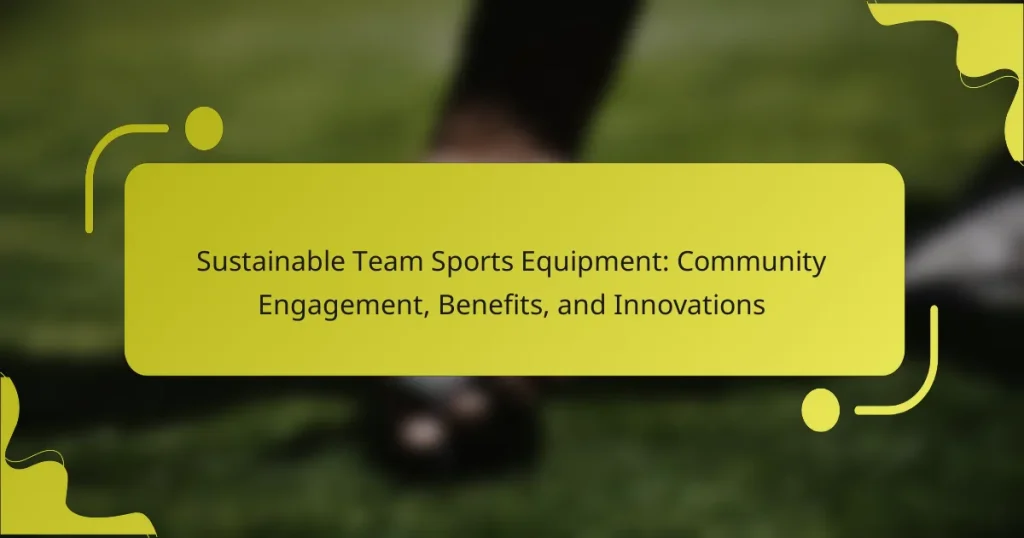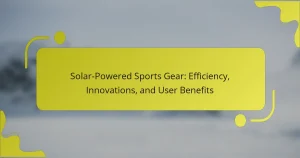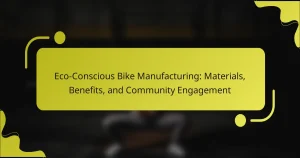Sustainable team sports equipment significantly reduces environmental impact while enhancing performance. This article explores community engagement initiatives, the benefits of eco-friendly materials, and innovations shaping the industry. It also addresses consumer preferences driving demand and the challenges manufacturers face in adopting sustainable practices.
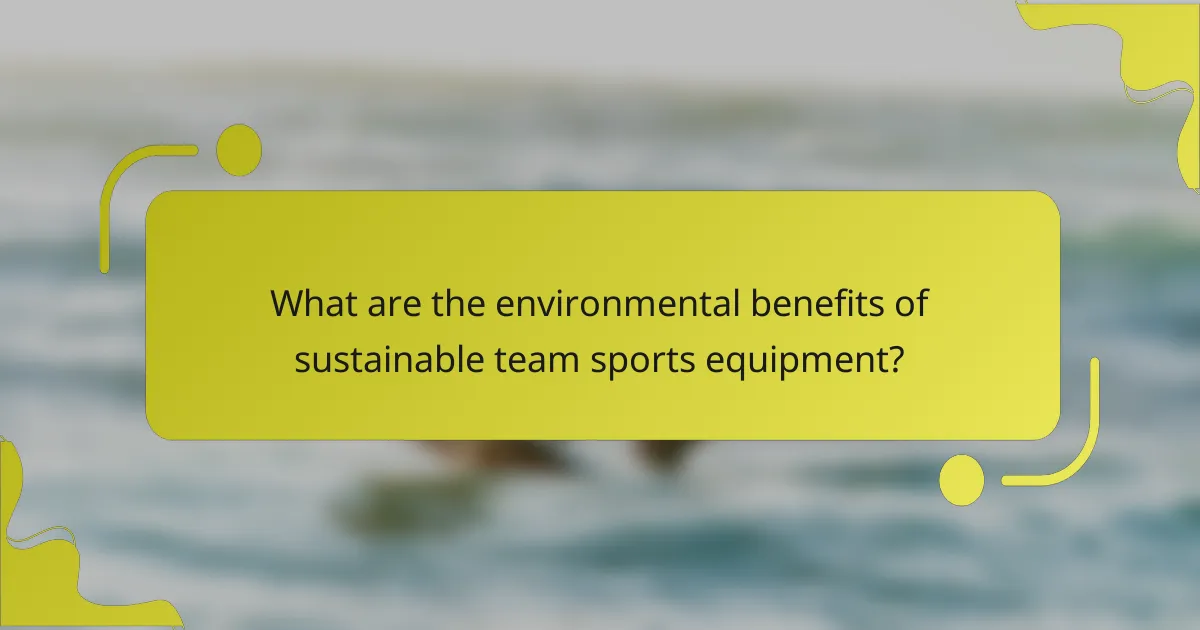
What are the environmental benefits of sustainable team sports equipment?
Sustainable team sports equipment offers significant environmental benefits. It reduces waste through the use of recyclable materials, minimising landfill contributions. Additionally, these products often utilise eco-friendly production processes that lower carbon emissions. Community engagement increases as teams promote sustainability, fostering awareness and encouraging responsible consumption. Innovations in design further enhance durability, extending the lifespan of equipment and reducing the need for replacements.
How does eco-friendly material choice impact performance?
Eco-friendly material choice enhances performance by increasing durability, reducing weight, and improving player comfort. Sustainable materials, like recycled plastics and organic fibres, often outperform traditional options in moisture management and breathability. For instance, equipment made from bio-based composites can provide better shock absorption and flexibility. As a result, teams using eco-friendly gear report higher satisfaction and engagement levels among players and fans.
Why is lifecycle assessment important for sports equipment?
Lifecycle assessment is crucial for sports equipment as it evaluates environmental impacts throughout the product’s life. This assessment informs sustainable practices, guiding manufacturers toward eco-friendly materials and processes. It fosters community engagement by promoting awareness of sustainability in sports. Moreover, it enhances the reputation of brands committed to environmental responsibility, ultimately benefiting both consumers and the planet.
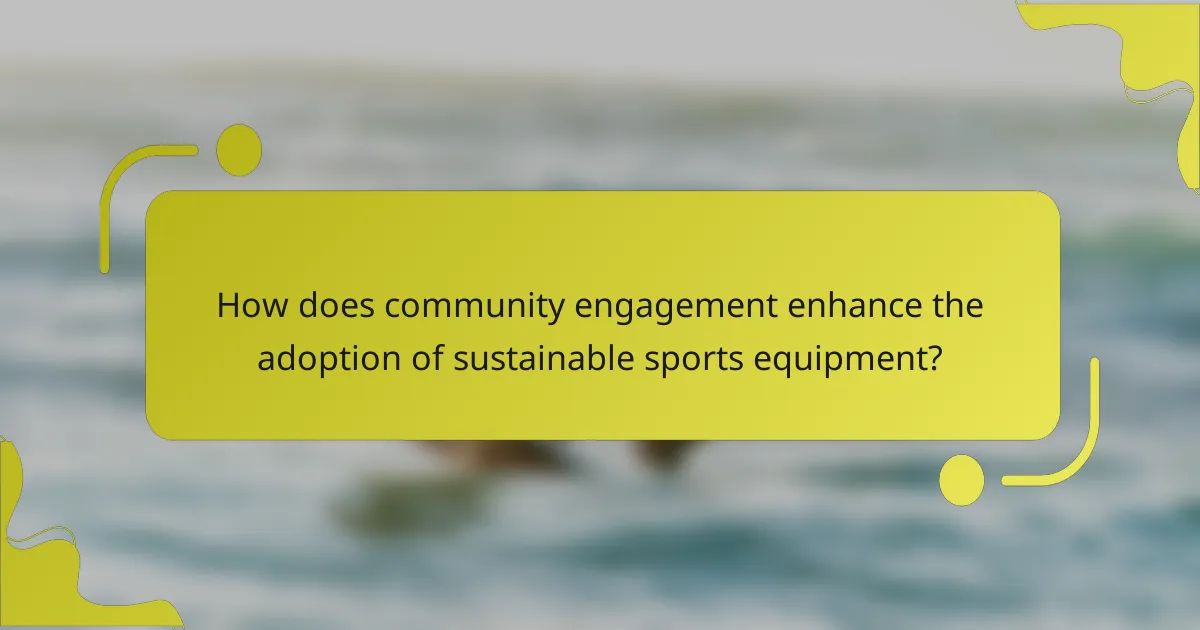
How does community engagement enhance the adoption of sustainable sports equipment?
Community engagement significantly boosts the adoption of sustainable sports equipment by fostering awareness and creating a sense of ownership. Local initiatives, such as workshops and events, educate athletes about the environmental benefits and performance advantages of sustainable options. Collaboration with community leaders enhances trust and encourages participation. As a result, teams and organisations are more likely to invest in eco-friendly gear, leading to increased demand and innovation in sustainable sports equipment.
What role do local sports organisations play in promoting sustainability?
Local sports organisations significantly promote sustainability by fostering community engagement, advocating for eco-friendly practices, and innovating sports equipment. They create awareness about sustainable materials, encourage recycling, and support local economies. For example, organisations may partner with manufacturers of sustainable sports gear, enhancing the availability of environmentally friendly options. This collaboration not only reduces waste but also educates athletes and community members on the importance of sustainability in sports. Additionally, local sports initiatives often host events focused on sustainability, further embedding these values within the community.
Which community events successfully showcase sustainable sports practices?
Community events that effectively showcase sustainable sports practices include eco-friendly tournaments, workshops on sustainable equipment, and community clean-up initiatives. These events promote awareness and engagement while demonstrating the benefits of sustainable practices in sports. For example, local leagues often host tournaments using biodegradable materials and recycled equipment, highlighting the environmental impact of sports. Additionally, workshops educate participants on the innovations in sustainable sports gear, fostering a community dedicated to environmental stewardship.
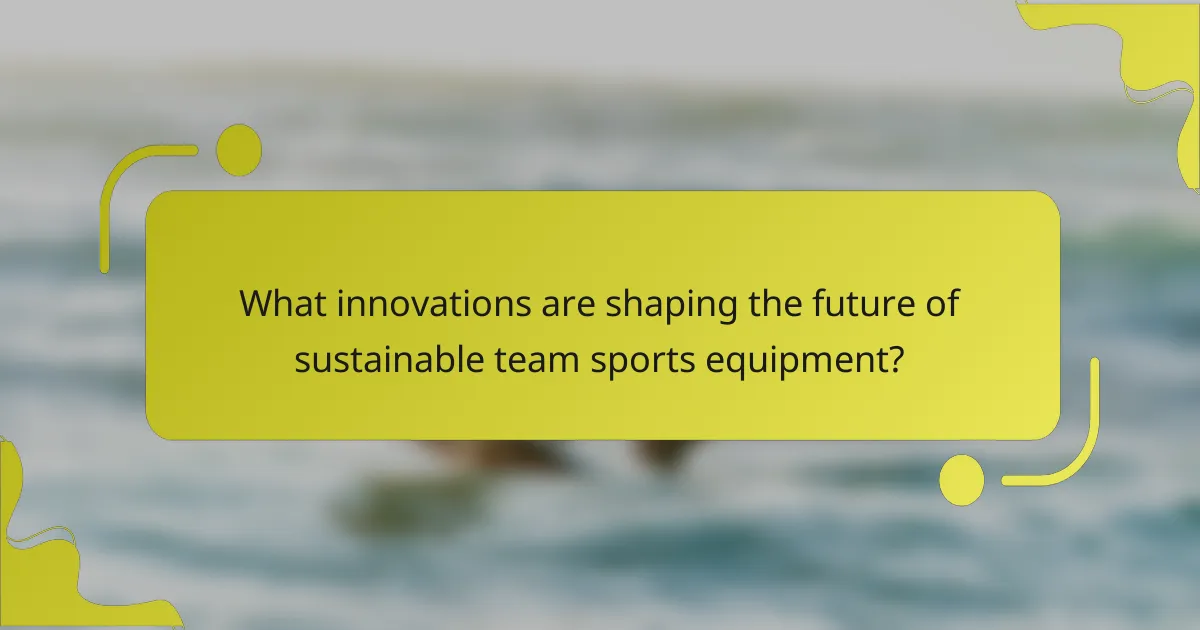
What innovations are shaping the future of sustainable team sports equipment?
Innovations shaping the future of sustainable team sports equipment include eco-friendly materials, 3D printing technology, and circular economy practices. These advancements reduce environmental impact and enhance performance. Biodegradable composites, for example, minimise waste while maintaining durability. Additionally, smart technology integration provides real-time data for improved training and player safety. As a result, the sports industry is increasingly prioritising sustainability, benefiting both athletes and the environment.
How is technology driving advancements in eco-friendly materials?
Technology is advancing eco-friendly materials by enhancing production processes and promoting sustainable practices. Innovations like bio-based composites and recycled plastics are transforming sports equipment. Smart manufacturing technologies reduce waste and energy consumption, fostering community engagement in sustainability efforts. Research shows that using renewable resources in sports gear can lower carbon footprints significantly. Additionally, collaborations between tech firms and sports organisations drive awareness and adoption of sustainable materials, creating a positive impact on the environment and communities.
Which brands are leading in sustainable sports equipment innovations?
Leading brands in sustainable sports equipment innovations include Patagonia, Adidas, and Nike. These companies focus on eco-friendly materials, ethical production, and community engagement. For example, Patagonia uses recycled polyester in many products. Adidas has developed shoes made from ocean plastic, while Nike promotes circular economy practices. These innovations reflect a commitment to sustainability and the benefits it brings to both communities and the environment.
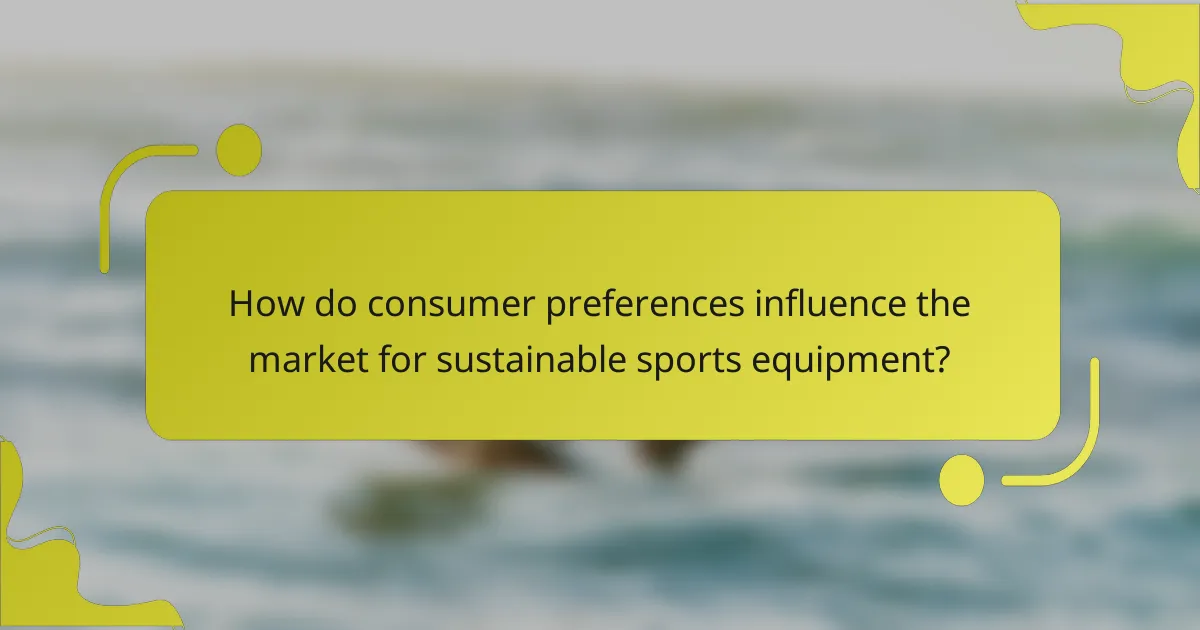
How do consumer preferences influence the market for sustainable sports equipment?
Consumer preferences significantly shape the market for sustainable sports equipment by driving demand for eco-friendly products. As consumers increasingly prioritise environmental responsibility, brands innovate to meet these needs, leading to the development of sustainable materials and production methods. Community engagement enhances this trend, as local initiatives promote awareness and participation in sustainable practices. For example, collaborative efforts between manufacturers and sports organisations foster a culture of sustainability, influencing consumer choices and encouraging the adoption of green products. This shift not only benefits the environment but also positions brands as leaders in sustainable innovation, appealing to a growing base of eco-conscious athletes.
What demographics are most inclined to choose sustainable options?
Individuals aged 18 to 34 are most inclined to choose sustainable options in team sports equipment. This demographic values environmental responsibility and innovation. Research indicates that millennials and Gen Z prioritise eco-friendly materials and practices. They are motivated by a desire to support brands that align with their sustainability values, enhancing community engagement.
How does pricing affect the adoption of sustainable sports equipment?
Pricing significantly influences the adoption of sustainable sports equipment by affecting accessibility and perceived value. Higher prices often deter consumers, while competitive pricing can enhance adoption rates.
Research indicates that when sustainable options are priced similarly to conventional equipment, consumers are more likely to choose them. For instance, community initiatives that subsidise costs can increase accessibility, thereby boosting adoption.
Additionally, educational campaigns highlighting the long-term benefits of sustainable sports equipment can justify higher initial costs. This approach can transform consumer perceptions, making sustainability a valued attribute in purchasing decisions.
In summary, aligning pricing strategies with consumer expectations and values is crucial for promoting sustainable sports equipment adoption.

What are the challenges faced by manufacturers of sustainable team sports equipment?
Manufacturers of sustainable team sports equipment face challenges such as high production costs, limited material availability, and consumer awareness. These factors can hinder the adoption of eco-friendly practices. Additionally, achieving performance standards while maintaining sustainability can be difficult. Engaging the community through education and outreach is essential to overcome these barriers and promote sustainable options.
How do production costs compare to traditional sports equipment?
Production costs for sustainable team sports equipment are often lower than traditional options due to innovative materials and processes. Sustainable equipment typically uses recycled or eco-friendly materials, reducing raw material costs. Additionally, community engagement initiatives often lower marketing expenses, as local support drives sales. For example, a study shows that sustainable equipment can reduce costs by 20% compared to traditional counterparts. As a result, teams can invest more in player development and community programmes.
What regulatory hurdles must be overcome in the sustainable sports market?
Regulatory hurdles in the sustainable sports market include compliance with environmental standards, safety regulations, and supply chain transparency. These factors impact the development and distribution of sustainable team sports equipment. Manufacturers must navigate complex regulations that vary by region, which can hinder innovation and increase costs. Additionally, securing certifications for eco-friendly materials presents challenges that require community engagement and collaboration among stakeholders.
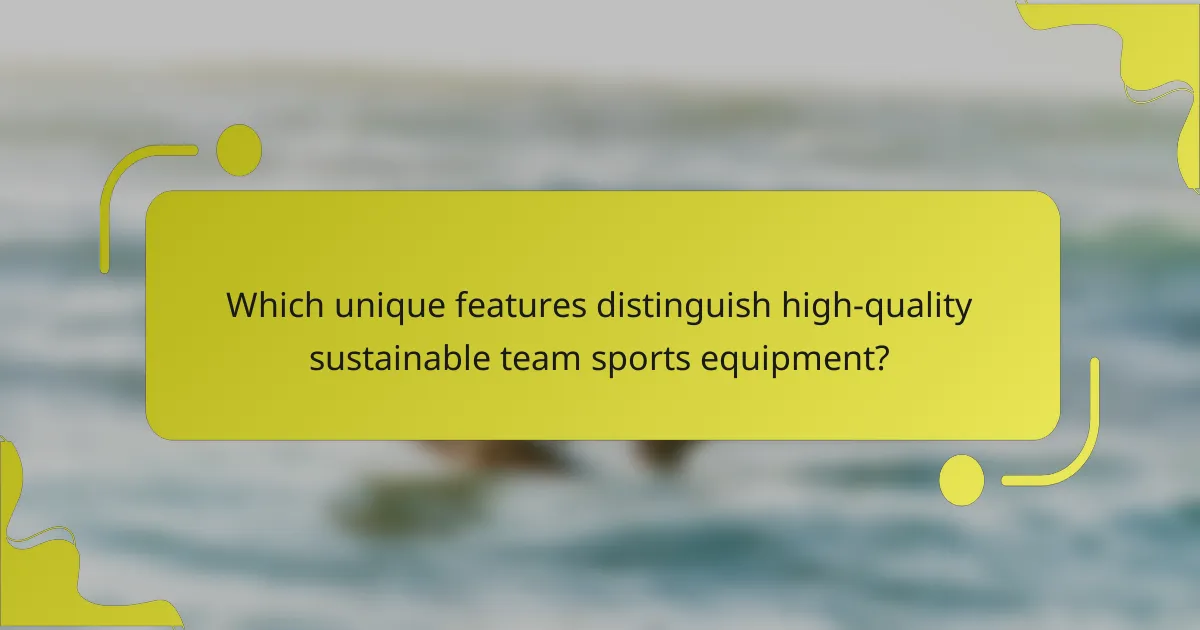
Which unique features distinguish high-quality sustainable team sports equipment?
High-quality sustainable team sports equipment is distinguished by its eco-friendly materials, innovative design, and community impact. These features contribute to reducing environmental footprints while enhancing performance and engagement.
Eco-friendly materials include recycled plastics, organic cotton, and biodegradable components. These materials minimise waste and promote sustainability in production processes.
Innovative design focuses on durability and functionality, ensuring equipment withstands rigorous use while maintaining performance. This includes ergonomic features that enhance user experience and safety.
Community impact is significant, as many brands engage in local initiatives, supporting youth sports programmes and promoting inclusivity. This connection fosters a sense of responsibility and encourages sustainable practices among athletes and teams.
How do performance metrics differ in sustainable versus conventional equipment?
Performance metrics for sustainable equipment prioritise environmental impact, while conventional equipment focuses on performance efficiency. Sustainable equipment often measures carbon footprint reduction, recyclability, and community engagement. In contrast, conventional metrics emphasise durability, cost-effectiveness, and immediate performance outcomes. This shift reflects growing awareness of sustainability’s role in sports.
What unique design elements are found in eco-friendly sports gear?
Eco-friendly sports gear often features unique design elements that prioritise sustainability. These include materials made from recycled plastics, organic cotton, and biodegradable substances. Innovative manufacturing processes reduce waste and energy consumption. Additionally, many designs incorporate modular components, allowing for easy repairs and upgrades, which extends the product’s lifecycle.

What are the best practices for integrating sustainable equipment into team sports?
Integrating sustainable equipment into team sports requires collaboration, innovation, and community involvement. Engaging local stakeholders fosters awareness and support for sustainable practices. Teams can host workshops to educate players and fans about the benefits of eco-friendly equipment, such as reduced environmental impact and improved performance. Utilizing recycled materials in gear design showcases innovation and commitment to sustainability. Establishing partnerships with sustainable brands can enhance credibility and provide access to cutting-edge products. Regularly evaluating equipment performance and environmental impact ensures continuous improvement and alignment with sustainability goals.
How can teams effectively transition to using sustainable equipment?
Teams can effectively transition to using sustainable equipment by prioritising education, collaboration, and innovation. Engaging all members in discussions about the environmental impact of equipment fosters a shared commitment. Collaborating with manufacturers can lead to innovations tailored to team needs, enhancing performance while reducing ecological footprints. Additionally, implementing a phased approach allows teams to gradually replace traditional equipment with sustainable alternatives, minimising disruption. Regularly assessing the benefits, such as improved community relations and reduced costs, reinforces the value of sustainable practices, encouraging ongoing adaptation.
What common mistakes should teams avoid when adopting sustainable practices?
Teams should avoid a lack of clear communication and inadequate training when adopting sustainable practices. Misunderstanding goals can lead to ineffective implementation. Failing to engage the community diminishes support and reduces impact. Additionally, overlooking the importance of measurable outcomes can hinder progress. Lastly, neglecting to evaluate existing resources may result in wasted efforts.
